Data Lake Market Size
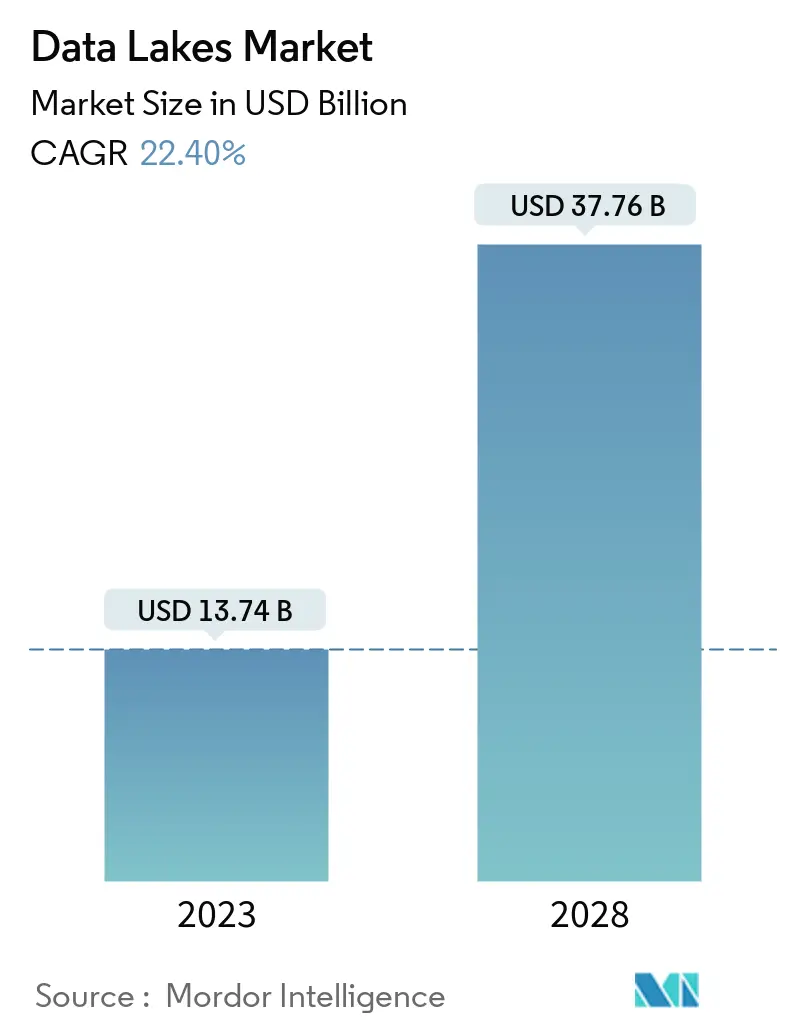
| Study Period | 2018-2028 |
| Market Size (2023) | USD 13.74 Billion |
| Market Size (2028) | USD 37.76 Billion |
| CAGR (2023 - 2028) | 22.40 % |
| Fastest Growing Market | Asia-Pacific |
| Largest Market | North America |
Major Players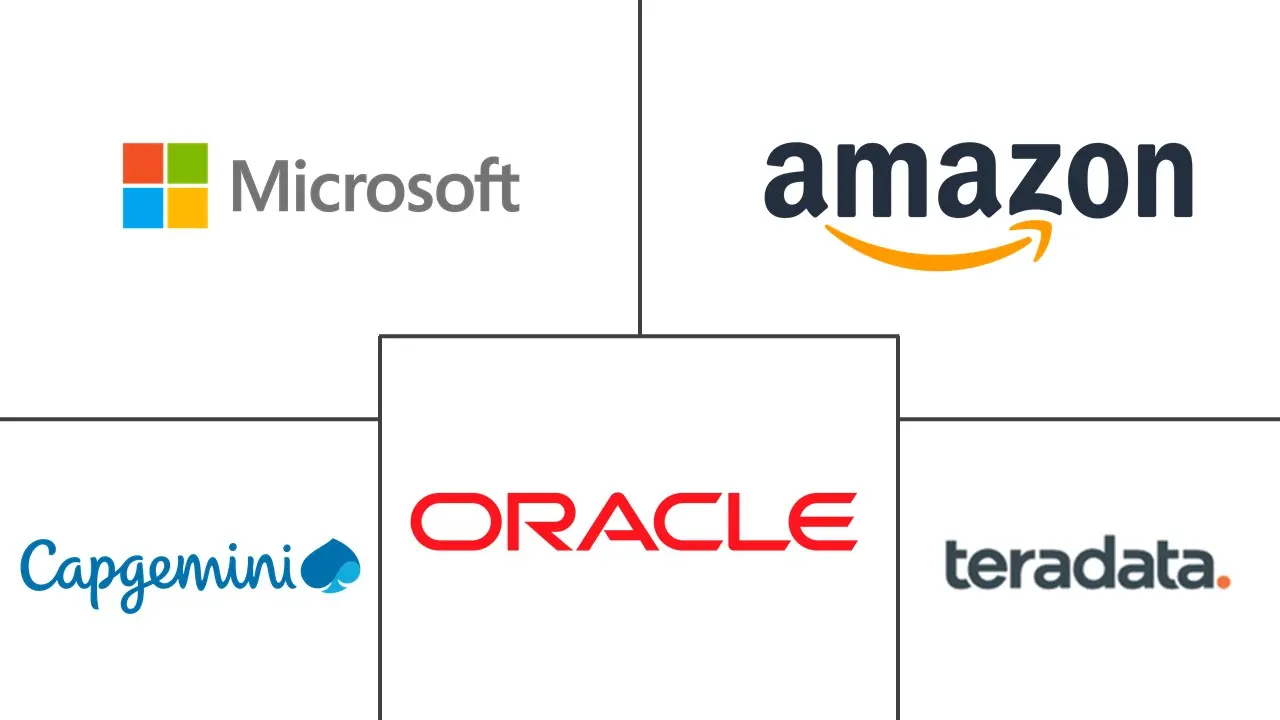
*Disclaimer: Major Players sorted in no particular order |
Need a report that reflects how COVID-19 has impacted this market and its growth?
Data Lake Market Analysis
The Data Lakes Market size is expected to grow from USD 13.74 billion in 2023 to USD 37.76 billion by 2028, at a CAGR of 22.40% during the forecast period (2023-2028).
Data lakes have become a more economical option for many companies than data warehousing. Data warehousing involves additional computing of data before entering the warehouse, unlike data lakes. The cost of maintaining a data lake is lower than a data lake due to the number of operations and space involved in building the warehouse database.
- One of the market's primary drivers is that data retrieval speed is better for data lakes than for data warehouses. According to the O'Reilly Data Scientist Salary Survey, one-third of the data scientists spend time doing basic operations such as necessary extraction, transformation, and loading (ETL), data cleaning, and basic data exploration rather than real analytics or data modeling, which reduces the efficiency of the process. In addition, the investment for setting up a data lake is less than that for setting up a data warehouse.
- IoT is being used more and more in offices and other places. This has made it even more important to have data lakes so that data manipulation can be done faster and better.The adoption of IoT devices is happening rapidly, as the amounts of data generated by the connected devices in the system are huge and the demand for data lakes is increasing. Government initiatives like building smart cities are also supporting their deployment. Enterprises also deploy big data and stream processing solutions to develop and maintain data lakes. The proliferation of data due to the adoption of IoT is driving market growth for the data lakes market.
- Businesses today are inclined toward data-driven decisions. The rise of digitalization is generating an enormous amount of data for organizations. With both medium- and large-scale enterprises investing in adopting technologies and security, data lakes eliminate the need for data modeling. Therefore, the demand for data lakes is increasing. Data lakes have emerged as a practical solution to exponentially increasing data as companies need efficient and advanced data analytical capabilities. The features of data lakes for processing data on the cloud fuel market growth.
- Several market players are coming out with new products and making improvements to stay ahead of the game.For instance, in February last year, Hermes released version 2 of its NG BI and Data Lakes software. Hermes' New Generation (NG) ecosystem includes various other cloud-based software solutions, including Hermes 5 Cloud CMS, Hermes NG BI and Data Lakes, and HMS, as well as self-service apps like Track & Trace and Slot Booking.
- With the start of COVID-19, the market saw some cloud-based innovations across different industry verticals and a change in the way people bought things. Researchers needed information about patients from all over the world in order to test how well these medicines would work. They used technology and data lakes to get this information quickly and successfully. Post-COVID-19 scenario, the market is expected to recover due to ongoing company investments in launching and developing solutions.
Data Lake Market Trends
Banking Sector to Witness a Significant Market Growth
Banks have been adding more data lakes to combine data from different areas into one central database.The Australia and New Zealand Banking Group (ANZ) has been implementing a project to aggregate all the data ponds across domains to create a main data lake for the banking operations, allowing the bank to shift from the typically used data warehouse architecture.
- Banks are investing in data engineers to provide more responsive data lakes to tackle consumer requirements and have also been trying to increase the utility of data for on-the-go solutions. State Bank of India (SBI) has provided data lakes to bank executives, deputy managing directors, and chief information officers to deliver on-the-go analytics apart from the typically used data warehouse.
- To stay on top of the market, many companies are launching and developing banking and finance solutions.For instance, in February last year, based in San Francisco, Databricks, a business that integrates the abilities of a data warehouse with a data lake in a single "lakehouse" design, launched a new industry-specific service known as Lakehouse for Financial Services. Databricks' Lakehouse for Financial Services is intended to provide customers with solutions that fit their specific technological and commercial needs.
- Also, in September of last year, Tres, the company that made the first financial data lake for Web3 enterprises, announced that it had raised USD 7.6 million in a seed phase led by bold start ventures, with help from F2, Mantis, New Form, The Chainsmokers, Blockdaemon Ventures, Kenetic, and Alchemy.
Deploying data lakes in the banking sector breaks down the number of silos. Storing data in a centrally managed infrastructure like Apache Hadoop–based data lake infrastructure helps reduce the number of information silos in an organization, making data accessible to users across the enterprise.
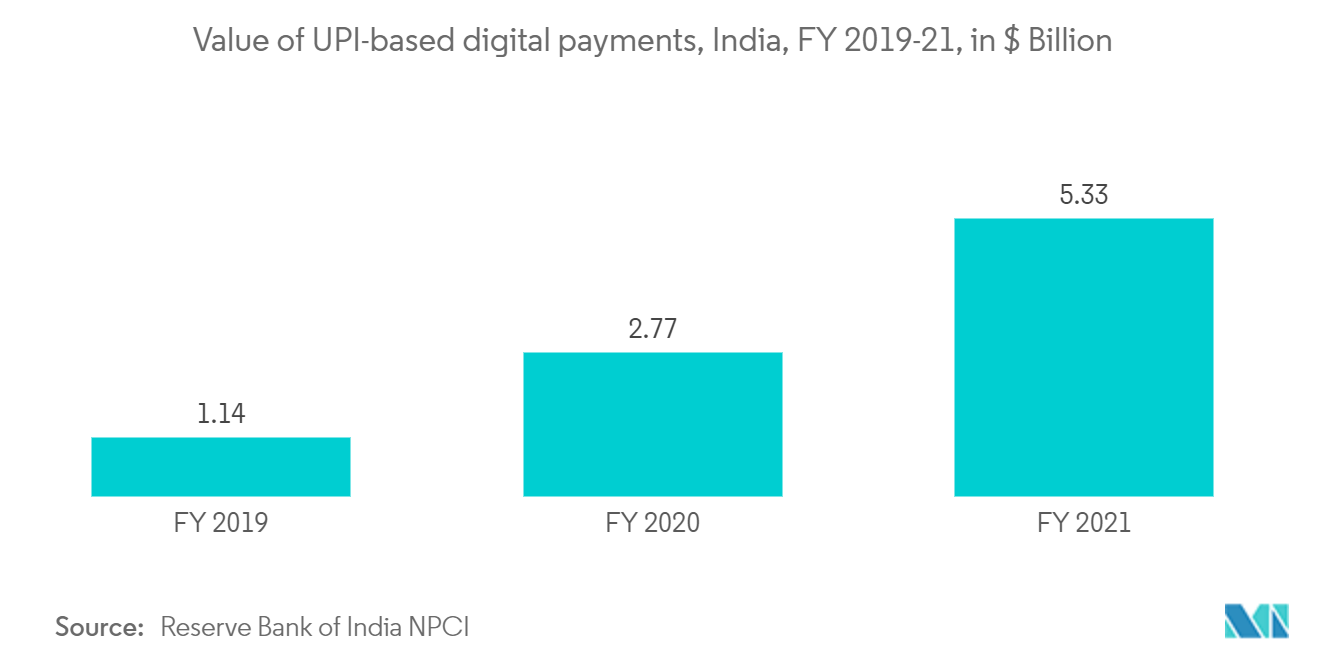
North America is Expected to have High Adoption for Data Lakes
- Capgemini says that more than 60% of U.S. financial institutions think that big data analytics gives them a big advantage over their competitors, and more than 90% of companies think that big data projects will determine how successful they will be in the future.
- Data lakes are needed for the use of smart meter applications. In Canada, BC Hydro uses an EMC data lake for analyzing data aggregated by various smart meters. The data then enables the detection of discrepancies in the system. This has aided in achieving 75% of electricity savings due to theft.
- The number of smart meters in the region has also been growing. Owing to an increase in the usage of smart meters, a huge amount of data is being generated, which requires the use of data lakes. According to the U.S. Energy Information Administration, over 94 million smart meters were installed in various residential, commercial, industrial, and transportation sectors.
- Moreover, in November last year, Amazon Web Services, headquartered in the U.S., announced five advanced features across its analytics and database portfolios to help clients analyze and manage data at petabyte scale more efficiently and quickly. Customers will find it simpler to operate high-performance analytics and database workloads at scale with these new features for Amazon OpenSearch Service, Amazon DocumentDB (with MongoDB compatibility), and Amazon Athena. AWS also unveiled a new AWS Glue solution for automatically managing the data quality across data lakes and pipelines.
The region’s market is driven by factors such as the increasing generation of data, such as clickstream data, server logs, subscriber data, customer relationship management (CRM), and enterprise resource planning (ERP), which are expected to boost the market's growth with vendors launching various data lake solutions and services. In addition, the higher adoption rate of AI and ML in the region is also expected to drive market growth.
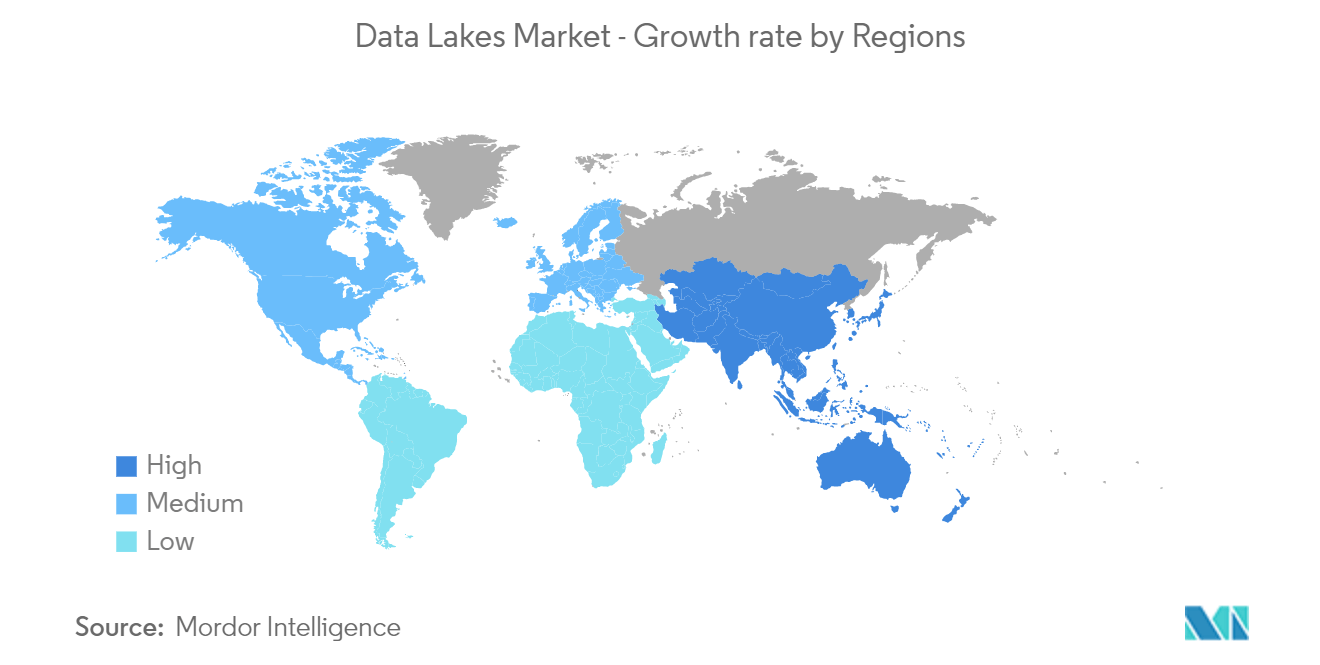
Data Lake Industry Overview
The market landscape is made up of companies that have been around for a long time and have strong brands, a large geographic footprint, and a large customer base.However, the market is concentrated. Companies such as Amazon and Microsoft, which hold a significant share of the cloud space, have a competitive edge over the existing market players due to consumer preference for cloud-delivered solutions and services.
In October 2022, Capgemini announced that long-time client Panasonic Automotive Systems would be getting a data ecosystem.The new platform can help an organization get better at making decisions based on data and coming up with new ideas. This can lead to more efficient and reliable extraction.
Teradata released VantageCloud Lake in August 2022. It was the company's first solution built with a brand-new cloud-native architecture. Based on Teradata's expertise and deep history, VantageCloud Lake introduces the proven power of Teradata Vantage in the cloud, now known as VantageCloud Enterprise, to a new cloud-born offering that is intended to be inevitably elastic and utilize a low-cost object store at its core, while remaining powerful, easy to use, and scaled (or stopped).
Data Lake Market Leaders
Microsoft Corporation
Amazon.com Inc.
Capgemini SE
Oracle Corporation
Teradata Corporation
*Disclaimer: Major Players sorted in no particular order
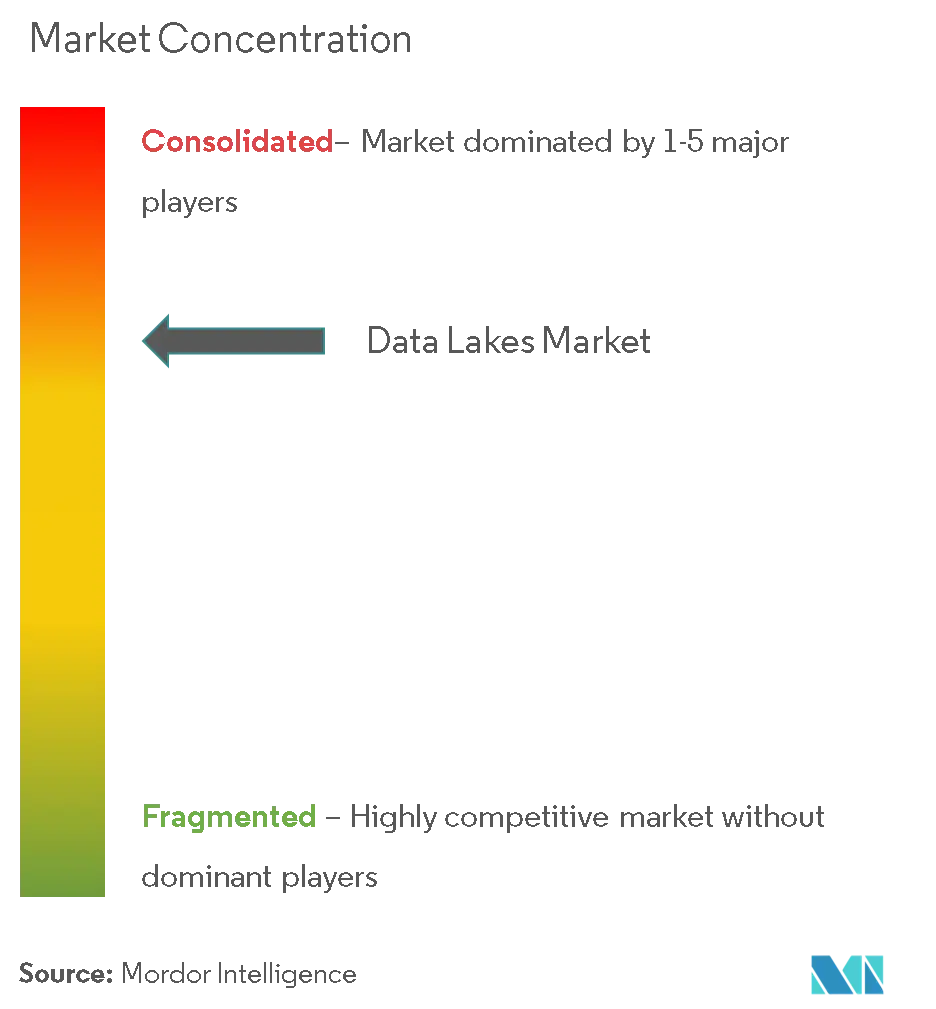
Data Lake Market News
- December 2022: Atos announced the development of a new solution in collaboration with AWS that allows clients to expedite and properly monitor company key performance indicators (KPIs) by offering simple access to non-SAP and SAP data silos. "Atos' AWS Data Lake Accelerator for SAP" is an innovative solution that delivers enterprise-wide and self-service reporting for significant insights into daily changes that rapidly impact decisions to drive the bottom line.
- November 2022: Amazon Web Services (AWS) announced the launch of Amazon Security Lake, a new cybersecurity solution that automatically centralizes safety data from on-premises and cloud sources into a purpose-built data lake in a user's AWS account.
- April 2022: Google introduced the preview launch of BigLake, a new data lake storage system that allows organizations to analyze data in their data lakes and warehouses, at its Cloud Data Summit.
Data Lake Market Report - Table of Contents
1. INTRODUCTION
1.1 Study Assumptions and Market Definition
1.2 Scope of the Study
2. RESEARCH METHODOLOGY
3. EXECUTIVE SUMMARY
4. MARKET INSIGHTS
4.1 Market Overview
4.2 Industry Attractiveness - Porter's Five Forces Analysis
4.2.1 Threat of New Entrants
4.2.2 Bargaining Power of Buyers
4.2.3 Bargaining Power of Suppliers
4.2.4 Threat of Substitutes
4.2.5 Intensity of Competitive Rivalry
4.3 Industry Value Chain Analysis
4.4 Assessment of Impact of COVID-19 on the Industry
4.5 Market Drivers
4.5.1 Proliferation of Data due to the Adoption of IoT
4.5.2 Need for Advanced Analytic Capabilities
4.6 Market Restraints
4.6.1 Slow Onboarding and Data Integration of Data Lakes
5. MARKET SEGMENTATION
5.1 Offering
5.1.1 Solution
5.1.2 Service
5.2 Deployment
5.2.1 Cloud-based
5.2.2 On-premise
5.3 End-user Vertical
5.3.1 IT and Telecom
5.3.2 BFSI
5.3.3 Healthcare
5.3.4 Retail
5.3.5 Manufacturing
5.3.6 Other End-user Verticals
5.4 Geography
5.4.1 North America
5.4.1.1 United States
5.4.1.2 Canada
5.4.2 Europe
5.4.2.1 United Kingdom
5.4.2.2 Germany
5.4.2.3 France
5.4.2.4 Italy
5.4.2.5 Rest of Europe
5.4.3 Asia-Pacific
5.4.3.1 China
5.4.3.2 Japan
5.4.3.3 India
5.4.3.4 Rest of Asia-Pacific
5.4.4 Latin America
5.4.4.1 Mexico
5.4.4.2 Brazil
5.4.4.3 Argentina
5.4.4.4 Rest of Latin America
5.4.5 Middle-East & Africa
5.4.5.1 United Arab Emirates
5.4.5.2 Saudi Arabia
5.4.5.3 South Africa
5.4.5.4 Rest of Middle-East & Africa
6. COMPETITIVE LANDSCAPE
6.1 Key Vendor Profiles
6.1.1 Microsoft Corporation
6.1.2 Amazon.com Inc.
6.1.3 Capgemini SE
6.1.4 Oracle Corporation
6.1.5 Teradata Corporation
6.1.6 SAP SE
6.1.7 IBM Corporation
6.1.8 Solix Technologies Inc.
6.1.9 Informatica Corporation
6.1.10 Dell EMC
6.1.11 Snowflake Computing Inc.
6.1.12 Hitachi Data Systems
7. INVESTMENT ANALYSIS
8. FUTURE OF THE MARKET
Data Lake Industry Segmentation
Data lakes offer better analytical capabilities to organizations. The scope of the study for the data lakes market has considered both cloud-based and on-premise solutions and services provided by vendors for a wide range of end-user verticals globally.
The data lakes market is segmented by offering (solution, service), deployment (cloud, on-premise), end-user vertical (BFSI, retail, healthcare, IT and telecommunications, manufacturing, others), and geography. The market sizes and forecasts are provided in terms of value (USD million) for all the above segments.
| Offering | |
| Solution | |
| Service |
| Deployment | |
| Cloud-based | |
| On-premise |
| End-user Vertical | |
| IT and Telecom | |
| BFSI | |
| Healthcare | |
| Retail | |
| Manufacturing | |
| Other End-user Verticals |
| Geography | |||||||
| |||||||
| |||||||
| |||||||
| |||||||
|
Data Lake Market Research FAQs
How big is the Data Lakes Market?
The Data Lakes Market size is expected to reach USD 13.74 billion in 2023 and grow at a CAGR of 22.40% to reach USD 37.76 billion by 2028.
What is the current Data Lakes Market size?
In 2023, the Data Lakes Market size is expected to reach USD 13.74 billion.
Who are the key players in Data Lakes Market?
Microsoft Corporation, Amazon.com Inc., Capgemini SE, Oracle Corporation and Teradata Corporation are the major companies operating in the Data Lakes Market.
Which is the fastest growing region in Data Lakes Market?
Asia-Pacific is estimated to grow at the highest CAGR over the forecast period (2023-2028).
Which region has the biggest share in Data Lakes Market?
In 2023, the North America accounts for the largest market share in the Data Lakes Market.
Data Lakes Industry Report
Statistics for the 2023 Data Lakes market share, size and revenue growth rate, created by Mordor Intelligence™ Industry Reports. Data Lakes analysis includes a market forecast outlook to 2028 and historical overview. Get a sample of this industry analysis as a free report PDF download.
